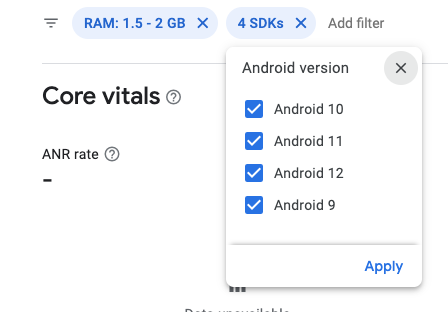অ্যান্ড্রয়েড প্ল্যাটফর্মে চলমান ডিভাইসগুলির মতো, গো ডিভাইসগুলিতে অ্যাপগুলি এখনও শেষ ব্যবহারকারীদের জন্য কার্যকর হওয়া উচিত। সিপিইউ, মেমরি, গ্রাফিক্স, নেটওয়ার্ক বা ডিভাইসের ব্যাটারির মতো সম্পদের অদক্ষ ব্যবহার কমানোর উপায় রয়েছে।
পারফরম্যান্সের সমস্যাগুলি সমাধান করতে, আপনি প্রোফাইলিং এবং বেঞ্চমার্কিং সরঞ্জামগুলি ব্যবহার করতে পারেন, আপনার অ্যাপের কর্মক্ষমতা প্রোফাইলে Android এর জন্য প্রদত্ত নির্দেশিকা সহ।
পরীক্ষার প্রয়োজনীয়তা
আপনার অ্যান্ড্রয়েড (গো সংস্করণ) অ্যাপের প্রোফাইলিং এবং পরীক্ষা করার সময় এখানে কয়েকটি মূল নির্দেশিকা মনে রাখতে হবে:
- Android 8.1 (API স্তর 27) বা তার উপরে সমর্থন করে এমন একটি ডিভাইসে পরীক্ষা করুন। একটি এমুলেটরের পরিবর্তে বাস্তব ডিভাইস (যদি সম্ভব হয়) ব্যবহার করা গুরুত্বপূর্ণ, কারণ CPU কর্মক্ষমতা ফলাফলকে প্রভাবিত করতে পারে।
- অ্যান্ড্রয়েড স্টুডিও মেমরি প্রোফাইলার বা পারফেটোর মতো সরঞ্জামগুলির মাধ্যমে আপনার র্যাম ব্যবহার নিরীক্ষণ করুন যাতে কতটা মেমরি খরচ হচ্ছে তার ট্র্যাক রাখতে। মেমরি লিক এবং মেমরি মন্থন শনাক্ত করা অ্যাপ ক্র্যাশ এবং সামগ্রিক জ্যাঙ্ক হ্রাস করতে পারে।
- নির্দিষ্ট সিস্টেম সীমাবদ্ধতার উপর ভিত্তি করে ক্রমবর্ধমানভাবে মেমরি প্রকাশ করতে, আপনি
onTrimMemoryপ্রয়োগ করতে পারেন। এই কলব্যাকটি অ্যাপগুলিকে সামগ্রিকভাবে আরও প্রতিক্রিয়াশীল সিস্টেম প্রদানে সহায়তা করার জন্য সংস্থানগুলি প্রকাশ করার অনুমতি দেয় এবং সিস্টেমটিকে আপনার প্রক্রিয়াটিকে দীর্ঘস্থায়ী রাখার অনুমতি দিয়ে আপনার অ্যাপের জন্য শেষ-ব্যবহারকারীর অভিজ্ঞতাকে সরাসরি উপকৃত করে। আরও তথ্যের জন্য,ComponentCallbacksএ ডকুমেন্টেশন দেখুন।
- নির্দিষ্ট সিস্টেম সীমাবদ্ধতার উপর ভিত্তি করে ক্রমবর্ধমানভাবে মেমরি প্রকাশ করতে, আপনি
- নিশ্চিত করুন যে আপনি Android (Go সংস্করণ) সমর্থিত নয় এমন সমস্ত বৈশিষ্ট্য অক্ষম করুন।
Go ডিভাইসের জন্য Android গুরুত্বপূর্ণ
অ্যান্ড্রয়েড (Go সংস্করণ) ডিভাইসে চলমান আপনার অ্যাপগুলির জন্য Android গুরুত্বপূর্ণ পরিসংখ্যান দেখতে, Google Play Console-এ নেভিগেট করুন এবং নিম্নলিখিত ফিল্টার এবং ডিভাইস কনফিগারেশন সেট করুন:
- ডিভাইসের ধরন : Android Go
- অ্যান্ড্রয়েড সংস্করণ : 8.1 এবং তার উপরে
- RAM : 2GB (Android 13 অনুযায়ী (API লেভেল 33) এবং উচ্চতর)। ডিভাইস এবং হার্ডওয়্যার স্পেসিফিকেশনের সম্পূর্ণ তালিকার জন্য, ন্যূনতম হার্ডওয়্যার স্পেসিফিকেশন দেখুন।

Android (Go সংস্করণ) ডিভাইসে বিশেষভাবে চলমান কোনো অ্যাপ দেখতে, আপনি চিত্র 2-এ দেখানো ডিভাইস ক্যাটালগে Android Go ফিল্টার প্রয়োগ করতে পারেন।


